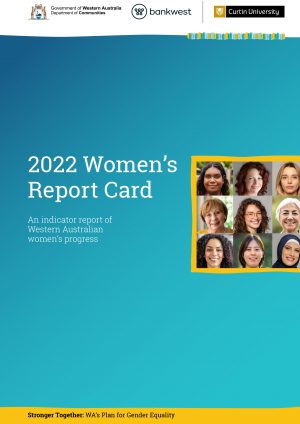Report card shows progress for more women in the workforce

— New women’s report card provides insight into the status of women in 2022 —
— Proportion of women on State Government Boards and committees is now 52.5 per cent —
— Women in the workforce at 64.5 per cent with societal attitudes changing —
The State Government has released its 2022 Women’s Report Card, showing how far WA women have progressed in terms of leadership, economic independence, safety and justice, and health and wellbeing.
Women’s interests Minister Simone McGurk said the report provides a comprehensive evidence base that assists policy development and service delivery across the Government, non-Government and private sectors. The report is issued every three years and is produced by the Department of Communities through the Bankwest Curtin Economics Centre.
This year’s report shows there is now greater gender equality in leadership in the public sector. In 2021, the proportion of women on state government boards and committees exceeded 50 per cent (52.5%) for the first time in Western Australia.
The number of women in the workforce has also reached the highest rate in Western Australia at 64.5 per cent, suggesting the ability to access the labour market is improving. 51.5 per cent of women work full-time, in comparison to 82.6 per cent for employed men, with a 12 percentage point increase in the use of childcare in the period. Enabling women to participate equally in the community, including at leadership levels, is a priority area of Stronger Together: WA’s Plan for Gender Equality, which was launched in March 2020.
WA’s gender pay gap continues to be the highest nationally at 21.2 per cent across all industries, down from 28.2 per cent since 2011.
Statistics from the 2022 Women’s Report Card include:
- Women’s workforce participation rate is 64.5 per cent – this is the highest ever rate for women in WA
- The proportion of employed women working full-time in WA is 51.5 per cent, in comparison to 82.6 per cent for employed men in WA
- However, WA’s gender pay gap is 21.2 per cent across all industries, down from 28.2 per cent in 2011, but higher than that reported nationally
- Women’s representation in CEO positions across Australian companies and the community sector has increased
- 59.5 per cent of university graduates are female, and have exceeded male graduates since 1985, particularly in the areas of law and accounting
- Teenage women giving birth in WA fell 26.6 per cent since 2016
- Cancer is the leading cause of death for women in WA
- Women continue to face a significantly higher risk of violence than men, particularly sexual and family and domestic violence with a 21 per cent increase in sexual assaults reported to WA police from 769 in 2018-19 to 935 in 2020-21
- Aboriginal and Torres Strait Islander women account for 68 per cent of hospitalisations due to family and domestic violence in WA
- The number of women assisted by specialist homelessness services has increased by 23 per cent in the last ten years
To view the 2022 Women’s Report Card and online data platform, visit: womensreportcard.communities.wa.gov.au
Comments attributed to Women’s interests Minister Simone McGurk:
“This year’s women’s report card shows there has been good progress in the areas of public sector leadership and economic independence for women in WA.
“It is encouraging to see that more organisations realise the benefits of greater diversity in their workforces, particularly recruiting women to leadership roles.
“Unfortunately other areas are slow to demonstrate improvement, including the gender pay gap in our State which is 21.2 per cent across all industries, the highest in the country.
“This is unacceptable and the State Government is working with partners from across government, the private and community sectors, and academia to deliver initiatives to address this.
“It is clear that while women are increasingly taking up employment opportunities, it is critical that businesses and industries work towards removing barriers for women to pursue careers and leadership opportunities in higher paying occupations that have traditionally been male-dominated.
“Long-lasting cultural change takes time and commitment across all sectors of the community. This Government is leading the way by creating change within the public sector and also through actions and initiatives to influence our stakeholders and the communities we support.”
Comments attributed to Dr Silvia Salazar, Research Fellow, Bankwest Curtin Economics Centre, and Women’s Report Card researcher
“This year’s report shows there is now greater gender equality in leadership in the public sector. In 2021, the proportion of women on state government boards and committees exceeded 50 per cent (52.5%) for the first time in Western Australia.
“By comparison, at the national level, private sector organisations still have a long way to go, with the proportion of women board members currently sitting at 33.4% in 2021.”





